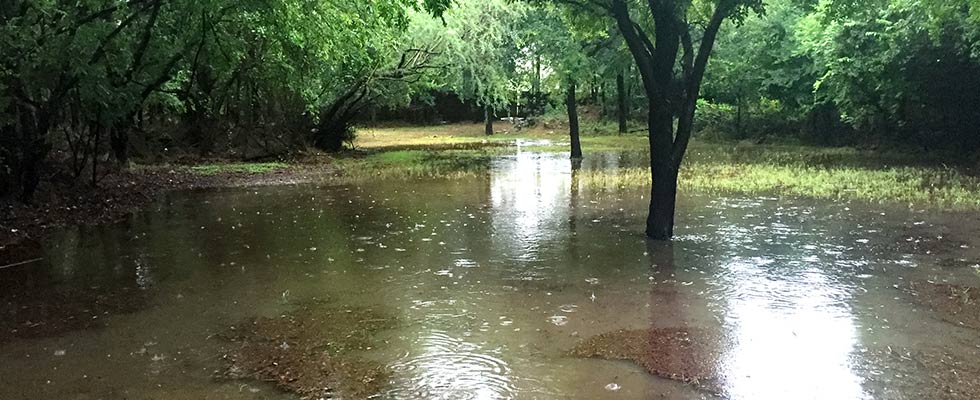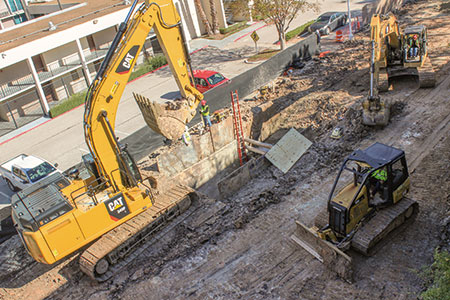
With substantial population growth in Texas, there are several challenging infrastructure problems cities in the state must solve, including stormwater management. With limited available real estate and rapidly rising real estate costs, traditional stormwater detention solutions, such as surface detention ponds, are becoming challenging to implement.
Cities in Texas are beginning to turn their attention to underground stormwater detention solutions. The city of Austin and city of Houston have recently embarked on two of the first major underground stormwater detention projects within the public right-of-way (ROW) in the state. There are many different considerations for when it makes sense to implement an underground detention solution. There are also many constructability challenges to address in the design of these systems.
Background
Texas is the fifth-fastest growing state in the nation, with the population growing by more than 1,000 people per day since 2019. Major Texas metros, including Austin and Dallas, made up two of the top five fastest growing metro areas in the country in 2022. With rising population growth comes rising real estate costs, requiring cities to evaluate how best to use the land available for public infrastructure and limit purchase of additional ROW and easements.
Along with population growth and development activity comes more impervious cover, causing additional stormwater runoff, which can strain existing stormwater systems and increase flood risk. With rising real estate costs, several large cities across Texas are now implementing underground detention systems to mitigate flood risk. Underground detention systems are widely used elsewhere in the United States, but the relative cost and availability of land in Texas has historically led to the use of traditional surface detention ponds. Since underground detention is a newer concept for Texas municipalities, there are no municipalities in the state with published design standards for underground detention systems.
.jpg)
Traditional surface ponds have generally been the go-to solution to attenuate increased runoff brought about by development. Surface water ponds can be constructed in many shapes and depths which optimize the space required for detention and can serve as multifunctional green space for parks and multiuse developments. When space is at a premium, the underground detention option offers a means to achieve stormwater runoff attenuation but typically is less efficient in that footprint and depth and more limited than surface water counterparts.
Hydraulic Considerations
Confirming an underground detention system will work hydraulically is critical. With no definitive design criteria in Texas, a software to use to analyze the system must first be chosen. An underground detention system is most effective at attenuating peak flow if it is offline, meaning flow along the storm drain trunk line is split, directing peak flow to the underground storage system and allowing lower flows to pass through. The stored peak flow is then released downstream in the storm sewer trunkline once the peak of the storm has passed, creating a parallel drainage system.
Parallel drainage systems can be modeled with steady state methods such as the hydraulic modeling system (HEC-HMS), StormCAD or PondPack. Municipalities often prefer the application of steady state modeling methods for sizing detention ponds and storm drain systems, as these are simplified models.
However, there are advantages of modeling these systems dynamically. Dynamic modeling can be done from the project onset, or a dynamic model can be used to backcheck the underground pond system hydraulic function. Examples of applicable dynamic models include the Environmental Protection Agency’s (EPA) Storm Water Management Model (XP-SWMM) or Infoworks ICM. No matter what program is chosen, it is critical to pair accurate hydraulic analysis with constructability considerations.
Project Examples
The city of Austin has a project designed to be the first underground detention system within the public ROW in the city. The system consists of three parallel 8-foot by 4-foot reinforced concrete boxes totaling approximately 500,000 gallons of detention volume. The parallel boxes are interconnected with 36-inch reinforced concrete pipe for equalization and access manholes are provided at regular intervals to provide maintenance access. The system inlet is a junction box which splits flow into a storm sewer pipe in low flow events and sends water into the detention system as flow increases. The system outlet includes a stainless-steel orifice plate to slowly release the water into the downstream storm sewer.
Facing challenges like Austin, Houston has already started to install in-line underground detention systems. The Memorial City Redevelopment Authority (Tax Increment Reinvestment Zone #17) installed an inline underground detention system which consisted of parallel reinforced concrete boxes assembled to store large amounts of water in lieu of constructing a surface detention basin. This design allowed the system to meet current city of Houston drainage criteria and the additional detention capacity within the system greatly relieved the downstream storm network.

A Viable Solution
Underground detention systems are a viable solution for flood risk mitigation, especially when real estate is limited or cost prohibitive. Carefully considering the hydraulics and constructability of the system is paramount to successful design and implementation of the system.

